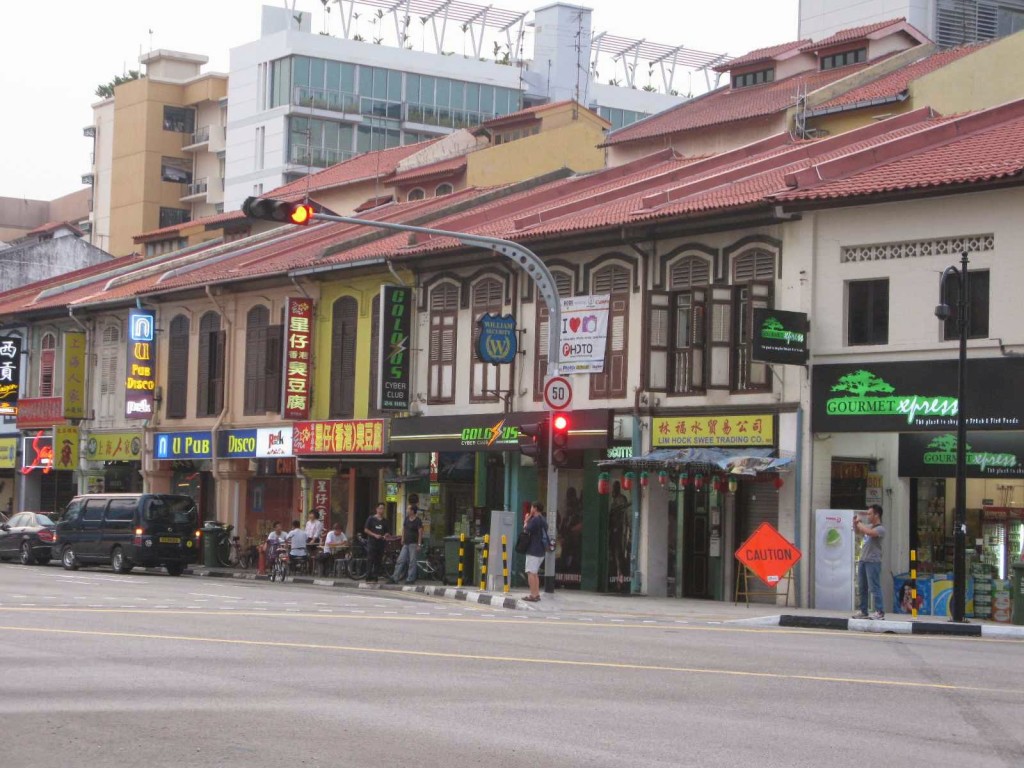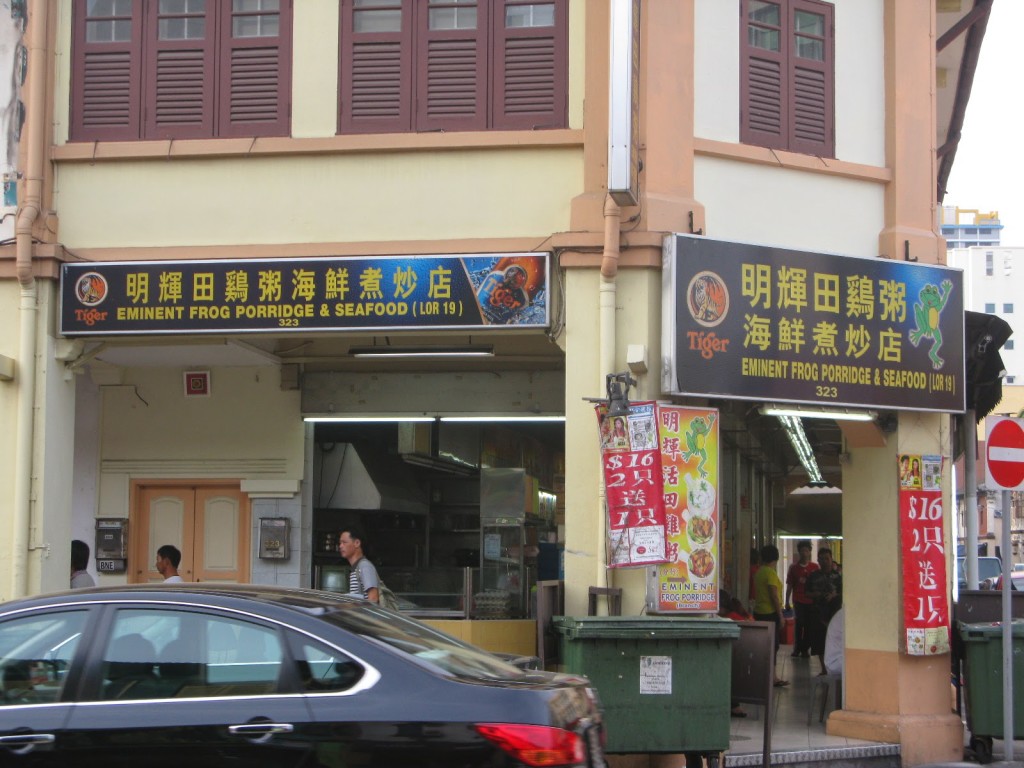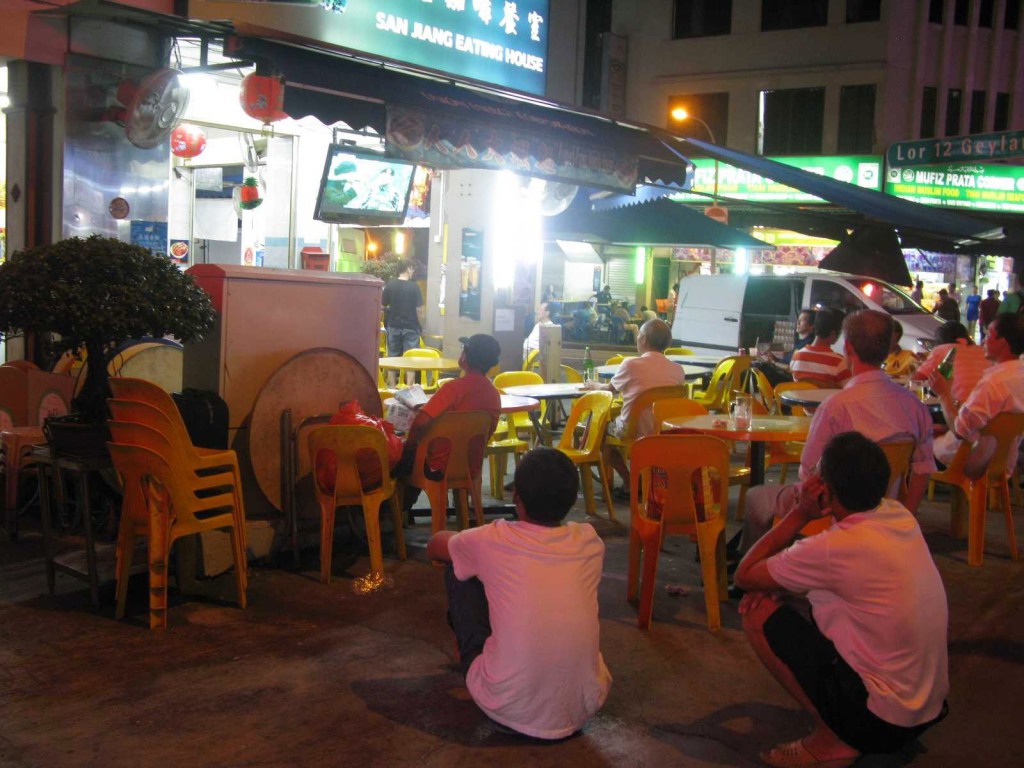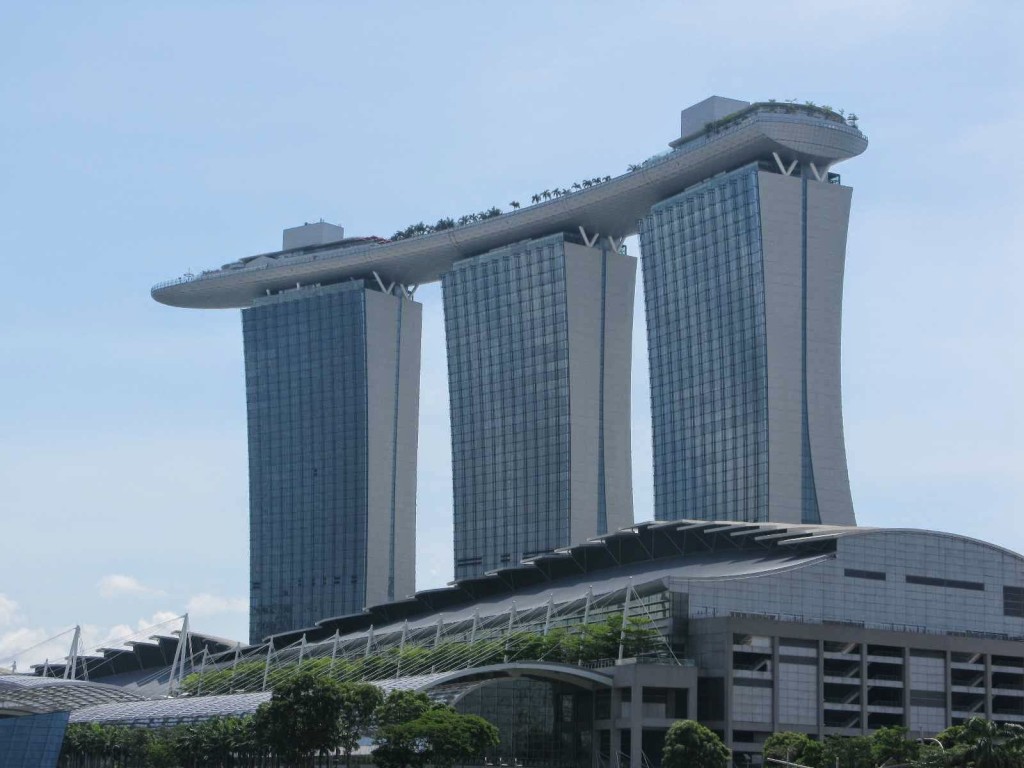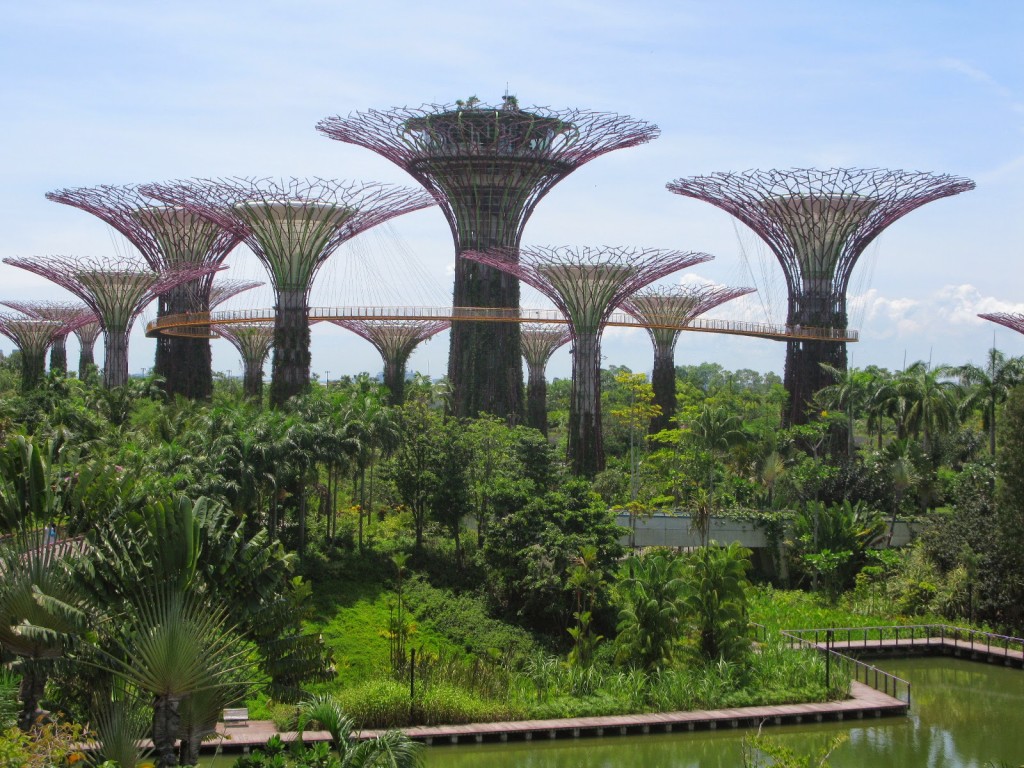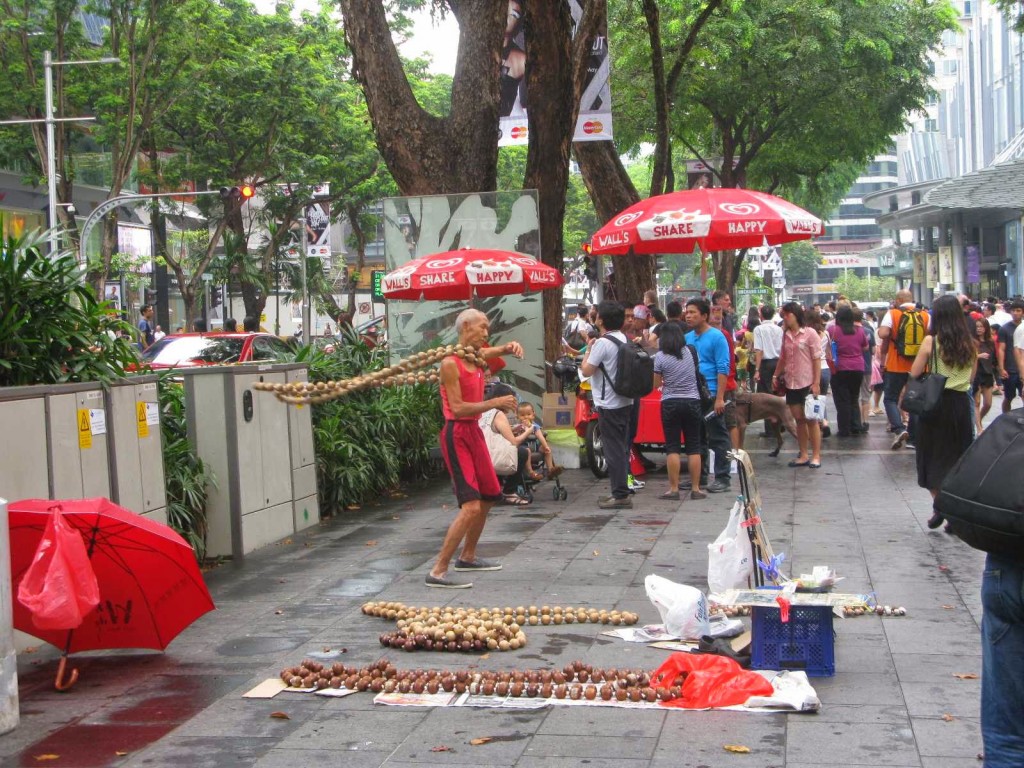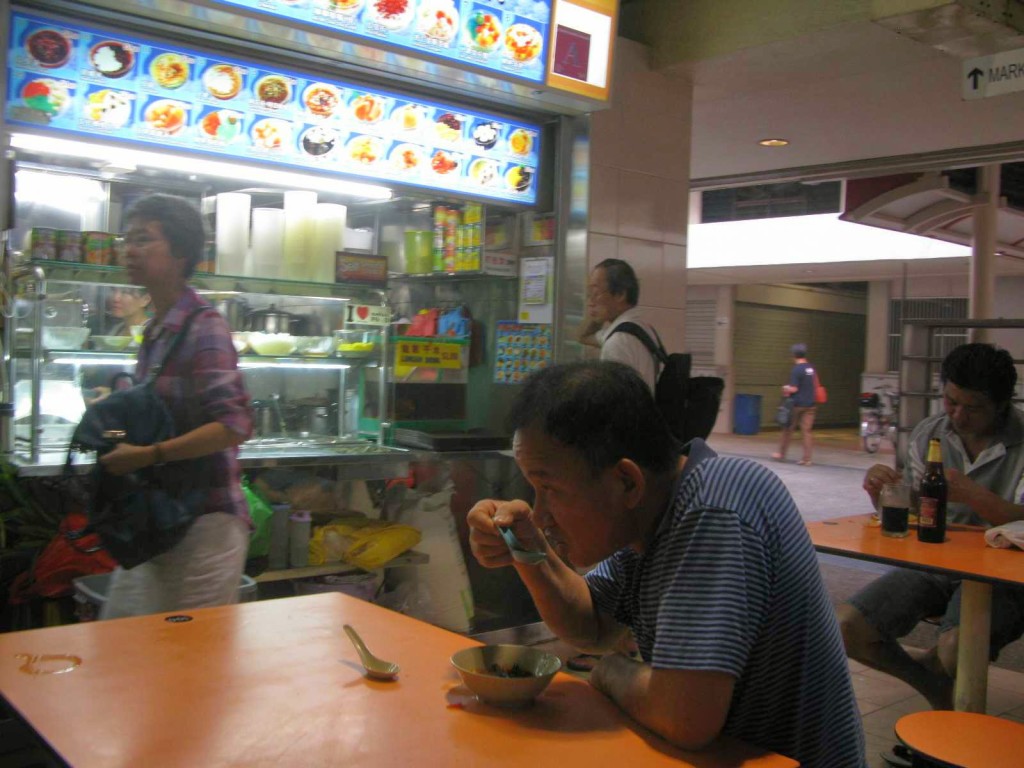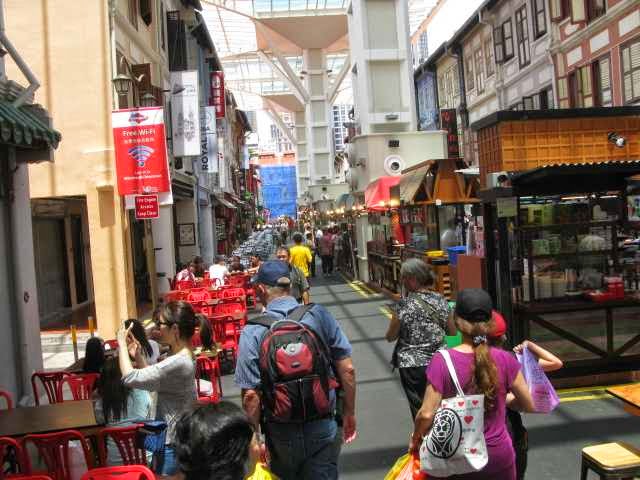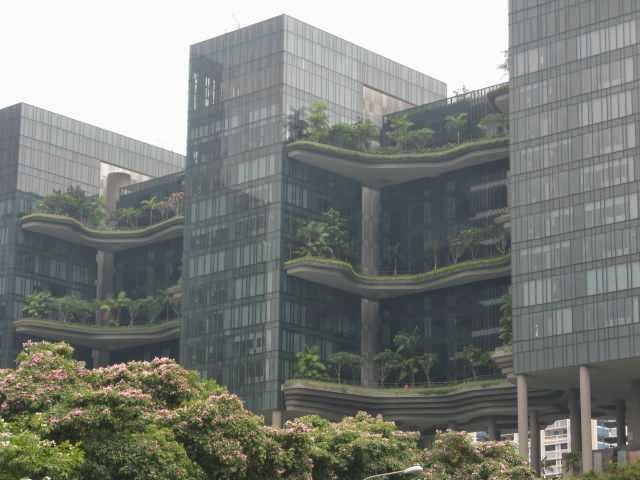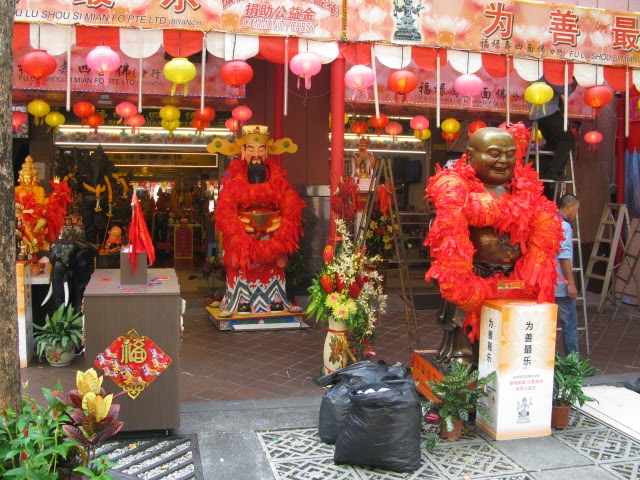The Tiger Airways flight that caried us from Chennai to Singapore was less than half full, so as soon as the door closed we each grabbed a row of three seats so that we could stretch out for the journey. It hadn’t been an unduly early start, and the flight was only 4 hours, but there was no entertainment – not even a meal since they were ridiculously expensive (£2 just for a tiny coffee). Still, what can you reasonably expect when you’ve only paid £50 for the ticket. We’d bought samosas at the airport, and we’d saved the remains of the previous night’s pizza for lunch. There wasn’t much to see on the long stretch across the Bay of Bengal, just a glimpse of an island that might have been Great Nicobar, but good views of Singapore as we circled round to land at Changi.
Singapore airport seemed like a different planet from India. Plush, carpeted, smooth, efficient, with touch screen terminals inviting you to provide feedback on the immigration ‘service’. An orderly queue for an airconditioned taxi – no need for a prepay system because the drivers always use the meter, and the 30 minute ride to Geylang, east of the city centre, cost only S$16, one of the few bargains in Singapore.
Our room at the Hotel 81 Princess was small, as we’d expected, and it took a bit of juggling to get our stuff stowed so that we didn’t fall over anything. That evening we explored our environs and sussed out our food options. Geylang is predominantly Peranakan (descendents of 19th century Chinese immigrants) and this is reflected in the eating places. Many of them featured trays of Malay/Chinese cooked food ready to be added to your plate on request – I’ve no idea how the charging worked as kept-warm food isn’t the safest, so we alwys looked for ones that cooked to order – most of these were Chinese, with a few Muslim Indian Malay places. Most were very cheap, open-fronted with tables spilling onto the pavement under an awning and walls displaying pictures of the menu items, with a 99% local clientele. Fortunately the first evening we picked one that had a menu in English – at under £3 per dish the serving sizes turned out to be larger than we expected so we ordered too much. However, while the food was cheap, £3.50 for a 660ml bottle of beer was an unpleasant surprise. After dinner we hit the biggest supermarket that we’d come across to buy something for breakfast – the hotel room had a kettle so it was an opportunity to cut costs, given that the hotel room alone cost more than our entire daily budget. We were probably hoping for something like Danish pastries, but the nearest we got were some small pastry buns filled with coconut and bean paste called tau sar and a couple of bready muffin things from Japan flavoured with chocolate and blueberry respectively. The were all perfectly edible, but not things that I will seek out in future.
Unfortunately when we got back to our room that first evening we couldn’t open the door – the key simply didn’t work. Perplexed, we must have checked the room number a dozen times, but it was definitely the right one. The receptionist tried various master keys to no avail. While a solution was pondered we waited in an adjoining room, moving our belongings there when the handle of our original room had been removed with a hammer and chisel.
Our priority in Singapore was to get a 60 day Indonesian visa. We could have got it ourselves by making several visits to the embassy, but I had found an agent willing to do it for a very reasonable fee so first thing the next morning we set off for the city centre on the clean, efficient and blisfully well air conditioned MTR. After doing the business with the paperwork we wandered north from Tras Street towards the soaring skyscrapers, ending up at Marina Bay. We had heard about the Marina Bay Sands Hotel while in India, and it certainly was impressive – three curving towers linked at the top by a boat-shaped platform. It was easy to imagine that the infinity pool on the top must have spectacular views, but we weren’t prepared to pay £12 each just to go up and take a photo. Instead we made do with a walk through the attached shopping mall, then across the elevated walkway that cuts through the middle of the hotel to the Gardens by the Bay. The gardens were pretty impressive too, with a grove of tall stylised trees connected by an aerial walkway.
As it rained heavily the next day we didn’t venture out until the afternoon, but made up for our laziness with a long trek along Geylang Road to a covered market – unfortunately many of the units were closed by the time we got there, perhaps because it was Friday evening prayer time at this area was predominately Muslim. So we ate in a food court opposite and walked home again. That night the air conditioning produced a small lake on the bedroom floor, so on the Saturday morning we had another room change. We were still on the 7th floor though – well above the rooms that were rented by the hour. Geylang’s main claim to fame these days is as Singapore’s red light district, and literally hundreds of girls hang around the covered walkways of Geylang Road’s shophouses and loiter outside the dozens of cheap hotels in the lanes off it. All these hotels will rent rooms by the hour, even those that are part of espectable chains. But the girls don’t bother tourists, at least not ones walking with their wives, so it’s no reason to avoid the area.
Our needs were more modest, and our choice of mall was determined by the location of the Kinokuniya bookshop, a Japanese emporioum that seemed to go on for ever and sold phrase books and language study books in every language you can think of and several I’d never even heard of. In the same mall was a Japanese department store, and its basement food court provided us with a very nice lunch of beer battered fish and chips in a sensibly sized portion. After scoring a free sample of chocolate pudding we commented that some free coffee would be nice (paying for one being out of the question) and, sure enough, there was a Nespresso stand handing out small cups of the stuff to those showing interest in the machines. We dutifully showed interest. Back at the mall by the MRT station we found a gourmet food shop and briefly drooled over the fairly ordinary but very expensive cheese on the shelves before discovering a cheese humidor stocked with French, Dutch and Spanish delights, and samples. We spent as much time in there as we dared before resolving to dine that evening on bread, some Lancashire cheese (half price at £20 a kilo!) and wine, the cheapest bottle of which was a French red reduced by 50% to £7. An expensive picnic, but never mind.
Singapore endeavours to squeeze as much vegetation as possible into the edges and corners of its urban landscape, but feeling the need for a larger expanse of greenery we headed for Singapore’s vast Botanic Gardens on the Sunday. It’s perhaps not as beautiful as I remember the ones in Kandy being, but it’s interestingly arranged with special sections showing, among others, the evolution of plants, medicinal plants, herbs & spices, and a rainforest section. As we’d breakfasted late (on croissants and jam in our room) we’d skipped lunch, so were more than ready for yet another Chinese food court meal, this time near the Aljunied MRT station on the way home.
The next morning we decided to try out Singapore’s buses – not as easy as the MRT as exact change is required, but buses give a better sense of the geography of a place and the number 2 took us straight to Chinatown. After a quick mall visit to try to get a SIM card, the hotel wifi being too slow and flaky for anything serious like downloading films (but we couldn’t get a SIM card without a passport) we took to the streets. Some of the shophouses had been nicely restored, but the pedestrianised streets lined with shops selling tourist tat gave the area a very artificial feel. The street set aside for food had a glass roof to avoid rain providing too much realism, and the stalls down the centre were identically designed, each adorned with a redundant wheel to remind you that originally these would have been carts.
But the wonton noodles were cheap and tasty. After lunch we visited the Buddha Tooth Relic Temple. It was only built in 2005, specifically to house the relic from Myabmar foundnin 1980, but it was still atmospheric, with a tranquil liitle roof garden with orchids and a large prayer wheel.
Having managed to exhaust the 6gB SIM card overnight, we returned the following day for another, followed by lunch in yet another food court. We then walked along the river to the financial district. Singapore’s skyscrapers are well designed – innovative shapes or glimpses of suspended garden areas prevent too much uniformity in the cityscape.
Having had a large lunch we didn’t fancy more Chinese food, so got some savoury pastries from an Indian place near the hotel, to have in our room with a supermarket beer.
Kampong Glam, the Arabic quarter, sounded interesting and was only a short bus ride from Geylang, but I wasn’t very impressed by it. We could have walked to Little India from there but it seemed a bit pointless after 5 months in the real thing, so instead we just walked through the area around and to the west of Bugis station. The latter turned out to be, in a way, more of a real Chinatown than the area that claims the title, with shops selling goods clearly aimed at Chinese people and palmistry stalls. Next door to a Chinese temple stood a Hindu Krishna temple at which, confusingly, the devotees seemed to be Chinese.
For our last meal in Singapore we again had noodles in a mall food court – but just for once it was not in the basement. Then it was home to pack our bags. I really did like Singapore – with a more generous budget you could find enough to do there to keep you occupied for weeks. But there’s no way that 2 people can live on £30 a day as tourists, (more like£60, even though we were relly careful) so it was time to go somewhere cheaper.
Our priority in Singapore was to get a 60 day Indonesian visa. We could have got it ourselves by making several visits to the embassy, but I had found an agent willing to do it for a very reasonable fee so first thing the next morning we set off for the city centre on the clean, efficient and blisfully well air conditioned MTR. After doing the business with the paperwork we wandered north from Tras Street towards the soaring skyscrapers, ending up at Marina Bay. We had heard about the Marina Bay Sands Hotel while in India, and it certainly was impressive – three curving towers linked at the top by a boat-shaped platform. It was easy to imagine that the infinity pool on the top must have spectacular views, but we weren’t prepared to pay £12 each just to go up and take a photo. Instead we made do with a walk through the attached shopping mall, then across the elevated walkway that cuts through the middle of the hotel to the Gardens by the Bay. The gardens were pretty impressive too, with a grove of tall stylised trees connected by an aerial walkway.
As it rained heavily the next day we didn’t venture out until the afternoon, but made up for our laziness with a long trek along Geylang Road to a covered market – unfortunately many of the units were closed by the time we got there, perhaps because it was Friday evening prayer time at this area was predominately Muslim. So we ate in a food court opposite and walked home again. That night the air conditioning produced a small lake on the bedroom floor, so on the Saturday morning we had another room change. We were still on the 7th floor though – well above the rooms that were rented by the hour. Geylang’s main claim to fame these days is as Singapore’s red light district, and literally hundreds of girls hang around the covered walkways of Geylang Road’s shophouses and loiter outside the dozens of cheap hotels in the lanes off it. All these hotels will rent rooms by the hour, even those that are part of espectable chains. But the girls don’t bother tourists, at least not ones walking with their wives, so it’s no reason to avoid the area.
Since we actually did need to buy a couple of things, we heading for the malls on Orchard Road the next day. The number of shops in Singapore really is just bewildering, and Orchard Road is just mall after mall after mall. I’ve no idea how on earth people collectively manage to spend enough money to sustain all those retailers, especially as the high end fashion labels are well represented, with shops like Prada having several branches.
Our needs were more modest, and our choice of mall was determined by the location of the Kinokuniya bookshop, a Japanese emporioum that seemed to go on for ever and sold phrase books and language study books in every language you can think of and several I’d never even heard of. In the same mall was a Japanese department store, and its basement food court provided us with a very nice lunch of beer battered fish and chips in a sensibly sized portion. After scoring a free sample of chocolate pudding we commented that some free coffee would be nice (paying for one being out of the question) and, sure enough, there was a Nespresso stand handing out small cups of the stuff to those showing interest in the machines. We dutifully showed interest. Back at the mall by the MRT station we found a gourmet food shop and briefly drooled over the fairly ordinary but very expensive cheese on the shelves before discovering a cheese humidor stocked with French, Dutch and Spanish delights, and samples. We spent as much time in there as we dared before resolving to dine that evening on bread, some Lancashire cheese (half price at £20 a kilo!) and wine, the cheapest bottle of which was a French red reduced by 50% to £7. An expensive picnic, but never mind.
Singapore endeavours to squeeze as much vegetation as possible into the edges and corners of its urban landscape, but feeling the need for a larger expanse of greenery we headed for Singapore’s vast Botanic Gardens on the Sunday. It’s perhaps not as beautiful as I remember the ones in Kandy being, but it’s interestingly arranged with special sections showing, among others, the evolution of plants, medicinal plants, herbs & spices, and a rainforest section. As we’d breakfasted late (on croissants and jam in our room) we’d skipped lunch, so were more than ready for yet another Chinese food court meal, this time near the Aljunied MRT station on the way home.
The next morning we decided to try out Singapore’s buses – not as easy as the MRT as exact change is required, but buses give a better sense of the geography of a place and the number 2 took us straight to Chinatown. After a quick mall visit to try to get a SIM card, the hotel wifi being too slow and flaky for anything serious like downloading films (but we couldn’t get a SIM card without a passport) we took to the streets. Some of the shophouses had been nicely restored, but the pedestrianised streets lined with shops selling tourist tat gave the area a very artificial feel. The street set aside for food had a glass roof to avoid rain providing too much realism, and the stalls down the centre were identically designed, each adorned with a redundant wheel to remind you that originally these would have been carts.
But the wonton noodles were cheap and tasty. After lunch we visited the Buddha Tooth Relic Temple. It was only built in 2005, specifically to house the relic from Myabmar foundnin 1980, but it was still atmospheric, with a tranquil liitle roof garden with orchids and a large prayer wheel.
It was only a short walk from there to Hana Express in Tras Street to pick up our passports complete with, hopefully, their Indonesian visas. We had to wait a while for the guy to return from the embassy, by which time quite a crowd had assembled on the pavement outside the office. Then it was back to the Singtel shop to get the SIM card and the MRT back to Geylang and a surprisingly good masala dosa for dinner.
Having managed to exhaust the 6gB SIM card overnight, we returned the following day for another, followed by lunch in yet another food court. We then walked along the river to the financial district. Singapore’s skyscrapers are well designed – innovative shapes or glimpses of suspended garden areas prevent too much uniformity in the cityscape.
Having had a large lunch we didn’t fancy more Chinese food, so got some savoury pastries from an Indian place near the hotel, to have in our room with a supermarket beer.
Kampong Glam, the Arabic quarter, sounded interesting and was only a short bus ride from Geylang, but I wasn’t very impressed by it. We could have walked to Little India from there but it seemed a bit pointless after 5 months in the real thing, so instead we just walked through the area around and to the west of Bugis station. The latter turned out to be, in a way, more of a real Chinatown than the area that claims the title, with shops selling goods clearly aimed at Chinese people and palmistry stalls. Next door to a Chinese temple stood a Hindu Krishna temple at which, confusingly, the devotees seemed to be Chinese.


